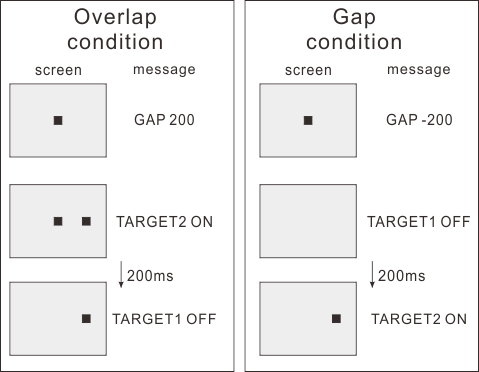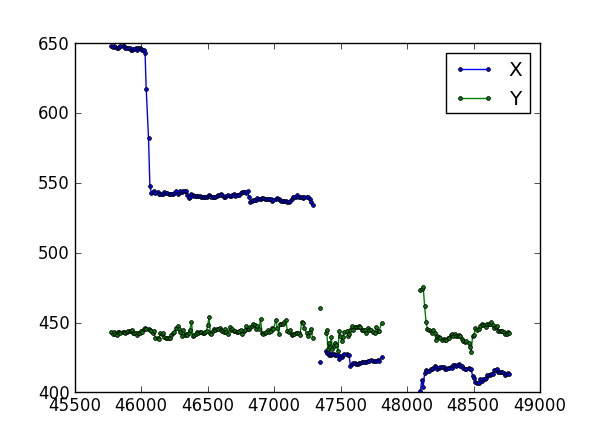Tutorial 02: Basic data analysis¶
This example shows a way to use the GazeParser library from IPython shell. Suppose that a GazeParser data file named 'data.db' exists in the current directory. To load this data file, import GazeParser module at first.
In [1]: import GazeParser
The GazeParser data file can be loaded using load() function.
In [2]: GazeParser.load('data.db')
Out[2]:
([<GazeParser.Core.GazeData at 0x51a6d50>,
<GazeParser.Core.GazeData at 0x51b8970>,
<GazeParser.Core.GazeData at 0x53dfb50>,
<GazeParser.Core.GazeData at 0x5408a70>],
None)
If data.db is in a subdirectory named experiment01/participant02, use relative path to specifile the file location.
In [3]: GazeParser.load('experiment01/participant02/data.db')
Out[3]:
([<GazeParser.Core.GazeData at 0x51a6d50>,
<GazeParser.Core.GazeData at 0x51b8970>,
<GazeParser.Core.GazeData at 0x53dfb50>,
<GazeParser.Core.GazeData at 0x5408a70>],
None)
GazeParser.load() returns a tuple of two elements. The first element is a list of GazeData objects.
Number of objects corresponds to how many times you have called the pair of startRecording() and stopRecording() when the data was recorded.
The second element is an 'additional data', which can be appended when the GazeParser data file was generated.
In this example, no additonal data is appended.
For ease of accessing data, let's reload the data file so that we can access the list of GazeParser.Core.GazeData objects with 'd'.
In [4]: d,a = GazeParser.load('data.db')
In [5]: d
Out[5]:
[<GazeParser.Core.GazeData at 0x51a6b30>,
<GazeParser.Core.GazeData at 0x53f3e70>,
<GazeParser.Core.GazeData at 0x53e4f70>,
<GazeParser.Core.GazeData at 0x5400170>]
GazeParser.Core.GazeData object has following data attributes. Using these attributes, you can calculate how many saccades were made within a certain period, total duration of fixation on a given region, how long did it take to make a saccade to a suddenly appeared stimulus, and so on.
attribute |
|
|---|---|
nSac |
Number of saccades detected in this data block. |
Sac |
A list of |
nFix |
Number of fixations detected in this data block. |
Fix |
A list of |
nBlink |
Number of blinks detected in this data block. |
Blink |
A list of |
nMsg |
Number of messages inserted in this data block. |
Msg |
A list of |
In this example, eye movements during performing Gap/Overlap task was recorded in the data file. In the Gap/Overlap task, participant fixated on a central target at the beginning of a trial. After an interval of random duration, a peripheral target was appeared at the left or right of the central target. Participant made a saccade as quickly as possible to the peripheral target. In GAP tials, the central target disappeared before the onset of the peripheral target. Contorary, in Overlap trials, the central target disappeared after the onset of the peripheral target.

Three messages were inserted in a trial. The first message was inserted when the trial was started. The message indicates condition of the trial. If the value following 'GAP ' in the message string is negative, the central target disappeared before the onset of the peripheral target (GAP trial). If positive, the central target disappeared after the onset of the peripheral target (Overlap tial). Absolute value indicates duration of gap or overlap period. In a single data block, 20 trials were performed.
You can check all messages in a data block using getMessageTextList() method.
In [6]: d[0].getMessageTextList()
Out[6]:
['GAP 200',
'TARGET1 OFF',
'TARGET2 ON',
'GAP -200',
'TARGET1 OFF',
'TARGET2 ON',
'GAP -200',
... (snip)
findMessage(). is useful to find messages that include specific text.
For example, following expression returns a list of messages that include 'TARGET2 ON'.:
d[0].findMessage('TARGET2 ON')
findMessage() supports regular expression. Use byIndices option to get found messages by indices.:
d[0].findMessage('GAP\s+-?[0-9]+', useRegexp=True)
It is known that latency of saccade (i.e. time of saccade onset from the onset of the peripheral target) is shorter in the gap condition compared to that in the overlap condition.
An easy way to calculate latency with the GazeParser library is to use getNextEvent() method.
This method returns the event (ie. saccade, fixation, blink or message) which followed the given event.
In this example, the third message was 'TARGET2 ON', which was inserted when the peripheral target was appeared.
To find the saccade following this message, call getNextEvent() like this.
In [7]: sac = d[0].getNextEvent(d[0].Msg[2],eventType='saccade')
Note that index of list starts with 0 in python. getNextEvent() can also be called from message object.
In [7]: sac = d[0].Msg[2].getNextEvent(eventType='saccade')
The saccade onset time is saved to 'startTime' attribute.
In [8]: sac.startTime
Out[8]: 2204.5
'startTime' holds the time from the beginning of the data block.
To get the saccade onset time relative to other event, use relativeStartTime() method.
Latency of this saccade was 302.8 ms.
In [9]: sac.relativeStartTime(d[0].Msg[2].time)
Out[9]: 302.79999999999995
To print latency of all saccades, use for statement. Not only GazeData but also
SaccadeData, FixationData, BlinkData
and MessageData have getNextEvent() method.
In [10]: for message in d[0].Msg:
...: if message.text == 'TARGET2 ON':
...: sac = message.getNextEvent(eventType='saccade')
...: print sac.relativeStartTime(message.time)
302.8
329.8
360.4
347.0
374.7
369.1
276.6
2161.1
244.7
315.4
246.8
319.0
241.9
65.1
272.5
2085.2
268.1
220.1
255.0
271.5
There are unreasonably large values (>2000) in the output.
A best way to see what happened in these trials is to inspect raw data.
quickPlot() is a helpful function in such a situation.
In the following example, the 16th output value (2085.2) is examined.
Because three messages were recorded in one trial, either (3*15+1)th or (3*15+2)th message should be 'TARGET2 ON'.
In [11]: d[0].Msg[3*15+1].text
Out[11]: 'TARGET2 ON'
In [12]: d[0].Msg[3*15+2].text
Out[12]: 'TARGET1 OFF'
If the particiant had made a saccade to this target, a saccade should have recorded between the (3*15+1)th and (3*16)th message (i.e., between the onset of the target and the beginning of the next trial).
In [13]: start = d[0].Msg[3*15+1].time
In [14]: end = d[0].Msg[3*16].time
In [15]: from GazeParser.Graphics import quickPlot
In [16]: quickPlot(d[0],period=(start,end),style='XYT')

Saccade detection was failed because of missing data although the participant made a saccade in this case.
In the following example, the saccade latencies in the Gap and Overlap trials were calculated while excluding too short (<100) or too long (>500) latency trials.
In [17]: latencyList = []
...: for message in d[0].Msg:
...: if message.text == 'TARGET2 ON':
...: sac = message.getNextEvent(eventType='saccade')
...: latency = sac.relativeStartTime(message.time)
...: if 100 <= latency <= 500:
...: latencyList.append(latency)
...: numpy.mean(latencyList)
Out[17]: 295.02456215994357
To examine whether the mean saccade latency in the Gap condition is shorter than that in the Overlap condition, the mean saccade latencies for the Gap and Overlap condition must be calculated separately. Save following script to a file (e.g. calcMeanLatency.py) and run it from IPython.:
import numpy
import GazeParser
gapLatency = []
overlapLatency = []
data,adata = GazeParser.load('data.db')
for d in data:
for trial in range(20):
if d.Msg[3*trial].text == 'GAP 200': #overlap condition
msg = d.Msg[3*trial+1] #TARGET2 ON should be the (3*trial+1)th message in this condition
sac = msg.getNextEvent(eventType='saccade')
latency = sac.relativeStartTime(msg.time)
if 100 <= latency <= 500:
overlapLatency.append(latency)
else: #gap condition
msg = d.Msg[3*trial+2] #TARGET2 ON should be the (3*trial+2)th message in this condition
sac = msg.getNextEvent(eventType='saccade')
latency = sac.relativeStartTime(msg.time)
if 100 <=latency <= 500:
gapLatency.append(latency)
print 'Gap: %.1f\tOverlap: %.1f' % (numpy.mean(gapLatency),numpy.mean(overlapLatency))
In [18]: run calcMeanLatency.py
Gap: 265.9 Overlap: 325.5
In this example, spatial propaties of saccades such as the starting point, termination point and amplitude was not considered.
If you want to check these properties, use data attributes of SaccadeData.
In [18]: sac = d[0].getNextEvent(d[0].Msg[2],eventType='saccade')
In [19]: sac.amplitude #saccade amplitude in deg
Out[19]: 4.3259570183555649
In [20]: sac.length #saccade amplitude in pixel
Out[20]: 104.95837270079979
In [21]: sac.start #starting point in the screen coordinate
Out[21]: (521.89999999999998, 437.30000000000001)
In [22]: sac.end #termination point in the screen coordinate
Out[22]: (626.79999999999995, 440.80000000000001)
Dealing with USB input data¶
SimpleGazeTracker 0.7.0 can record USB input simultaneously with gaze data.
If USB inputs are included in the data, hasUSBIOData() returns True.
USB input can be accessed through USBIOData attribute of GazeData.
Order of channels is held at USBIOChannels attribute of GazeData.
In [4]: d,a = GazeParser.load('data.db')
In [5]: d[0].hasUSBIOData()
Out[5]: True
In [6]: d[0].USB
Out[6]: d[0].USBIOChannels
Out[6]: [u'AD0', u'AD1', u'DI']
In [7]: d[0].USBIOData
Out[7]:
array([[2046, 2047, 255],
array([[2011, 2043, 255],
array([[2017, 2044, 255],
....
array([[3110, 1994, 127],
array([[3102, 1990, 127],
array([[3099, 1998, 127]])
Dealing with calibration data¶
SimpleGazeTracker 0.8.0 records summary of calibration results in the data file.
Calibration results are imported to 'CalPointData' data attribute of GazeData.
'CalPointData' data attribute is a list of GazeParser.Core.CalPointData object.
In [1]: d,a = GazeParser.load('data.db')
In [2]: d[0].CalPointData
Out[2]:
[<GazeParser.Core.CalPointData at 0x37ff790>,
<GazeParser.Core.CalPointData at 0x37ff810>,
<GazeParser.Core.CalPointData at 0x37ff830>,
<GazeParser.Core.CalPointData at 0x37ff850>,
<GazeParser.Core.CalPointData at 0x37ff870>,
<GazeParser.Core.CalPointData at 0x37ff890>,
<GazeParser.Core.CalPointData at 0x37ff8b0>,
<GazeParser.Core.CalPointData at 0x37ff8d0>,
<GazeParser.Core.CalPointData at 0x37ff8f0>]
CalPointData has 'point', 'accuracy' and 'precision' atttributes.
nan indicates that data is not available. For example, right eye's data is not available when only left eye is recorded.
In [3]: d[0].CalPointData[0].point
Out[3]: array([ 350., -250.])
In [4]: d[0].CalPointData[0].accuracy
Out[4]: array([-19.581205, 10.108988, nan, nan])
In [5]: d[0].CalPointData[0].precision
Out[5]: array([20.099655, 9.640429, nan, nan])
Use getAccuracy() and getPrecision() to specify which eye's data you need.
In [6]: d[0].CalPointData[0].getPrecision(eye='L')
Out[6]: array([20.099655, 9.640429], dtype=object)
Each GazeParser.Core.CalPointData object holds information on a single calibration point.
If you want to calibration data for all calibration points, GazeParser.Core.GazeData.getCalPointDataByList() is convenient.
In [6]: d[0].getCalPointDataByList()
Out[6]:
array([[350.0, -250.0, -19.581205, 10.108988, nan, nan, 20.099655,
9.640429, nan, nan],
[0.0, 250.0, -15.328429, 20.622807, nan, nan, 16.183005,
20.492021, nan, nan],
[0.0, 0.0, 15.916396, -8.670573, nan, nan, 15.431423, 9.244815,
nan, nan],
[0.0, -250.0, -9.560707, 18.605805, nan, nan, 11.590791,
20.255189, nan, nan],
[-350.0, -250.0, 8.718887, -0.562188, nan, nan, 8.25249, 1.47527,
nan, nan],
[350.0, 0.0, 21.822557, -23.568509, nan, nan, 21.378845,
24.085564, nan, nan],
[-350.0, 0.0, -1.987498, -16.53633, nan, nan, 2.827205, 17.075086,
nan, nan],
[-350.0, 250.0, nan, nan, nan, nan, nan, nan, nan, nan],
[350.0, 250.0, nan, nan, nan, nan, nan, nan, nan, nan]], dtype=object
)
